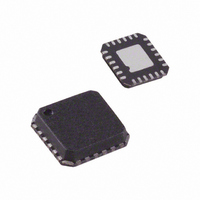ADL5385ACPZ-R7 Analog Devices Inc, ADL5385ACPZ-R7 Datasheet - Page 16

ADL5385ACPZ-R7
Manufacturer Part Number
ADL5385ACPZ-R7
Description
IC, QUAD MODULATOR 50MHZ-2.2GHZ LFCSP-24
Manufacturer
Analog Devices Inc
Datasheet
1.ADL5385ACPZ-R7.pdf
(24 pages)
Specifications of ADL5385ACPZ-R7
Frequency Range
50MHz To 2.2GHz
Rf Type
Quadrature
Supply Voltage Range
4.75V To 5.5V
Rf Ic Case Style
LFCSP
No. Of Pins
24
Operating Temperature Range
-40°C To +85°C
Design Resources
Broadband Low EVM Direct Conversion Transmitter Using LO Divide-by-2 Modulator (CN0144)
Function
Modulator
Lo Frequency
50MHz ~ 2.2GHz
Rf Frequency
50MHz ~ 2.2GHz
P1db
8dBm
Noise Floor
-160dBm/Hz
Output Power
2.6dBm
Current - Supply
240mA
Voltage - Supply
4.75 V ~ 5.25 V
Test Frequency
2.15GHz
Package / Case
24-VFQFN, 24-CSP Exposed Pad
Rohs Compliant
Yes
Lead Free Status / RoHS Status
Lead free / RoHS Compliant
Other names
ADL5385ACPZ-R7TR
ADL5385
Using AD9777 Auxiliary DAC for Carrier Feedthrough
Nulling
The AD9777 features an auxiliary DAC that can be used to
inject small currents into the differential outputs for each
channel. The auxiliary DAC can produce the small offset
currents necessary to implement the nulling described in the
Carrier Feedthrough Nulling section.
155 Mbps (STM-1) 128 QAM TRANSMITTER
Figure 34 shows how the ADL5385 can be interfaced to the
AD9777 DAC (or any Analog Devices dual DAC with an output
bias level of 0.5 V) to generate a 155 Mbps 128 QAM carrier at
355 MHz. Because the TxDAC output and the IQ modulator inputs
operate at the same bias levels of 0.5 V, a simple dc-coupled
connection can be implemented without any active or passive
level shifting. The bias level and modulator drive level is set by
the 50 Ω ground-referenced resistors and the 100 Ω shunt
resistors, respectively (see the DAC Modulator Interfacing
section). A baseband filter is placed between the bias and signal
swing resistors. This 5-pole Chebychev filter with in-band
ripple of 0.1 dB has a corner frequency of 39 MHz.
CHANNEL
CHANNEL
Figure 35 shows a spectral plot of the 128 QAM spectrum at
a carrier power of −6.3 dBm. Figure 36 shows how EVM
(measured with the analyzer’s internal equalizer both on and
off) and SNR, measured at 55 MHz carrier offset (2.5 times the
carrier bandwidth) varies with output power.
Figure 35. Spectral Plot of 128 QAM Transmitter at −6.3 dBm Output Power
AD9777
AD9777
Q
–100
–110
–120
–130
–140
–150
–160
I
1/2
1/2
–70
–80
–90
Figure 34. Recommended DAC-Modulator Interconnect for128 QAM
290
300
50Ω
50Ω
50Ω
50Ω
50Ω LINE
50Ω LINE
50Ω LINE
50Ω LINE
310
67.5pF
67.5pF
67.5pF
67.5pF
320
330
317.4nH
317.4nH
317.4nH
317.4nH
FREQUENCY (MHz)
340
Transmitter
350
156.9pF
156.9pF
156.9pF
156.9pF
372.5nH
372.5nH
372.5nH
372.5nH
360
370
124.7pF
124.7pF
124.7pF
124.7pF
380
100Ω LINE
100Ω LINE
100Ω LINE
100Ω LINE
390 400
0Ω
0Ω
0Ω
0Ω
200Ω
200Ω
410
420
IBBP
IBBN
QBBP
QBBN
ADL5385
Rev. 0 | Page 16 of 24
CMTS TRANSMITTER APPLICATION
Because of its broadband operating range from 50 MHz to
2200 MHz, the ADL5385 can be used in direct-launch cable
modem termination systems (CMTS) applications in the
50 MHz to 860 MHz cable band.
The same DAC and DAC-to-modulator interface and filtering
circuit shown in Figure 34 was used in this application. Figure 37
shows a plot of a 4-carrier 256 QAM spectrum at an output
frequency of 485 MHz. Figure 38 shows how adjacent channel
power (measured at 750 KHz, 5.25 MHz, and 12 MHz offset
from the last carrier) and modulation error ratio (MER) vary
with carrier power.
Figure 36. EVM and SNR vs. Output Power for 128 QAM Transmitter
Figure 37. Spectrum of 4-Carrier 256 QAM CMTS Signal at 485 MHz
79
77
75
73
71
69
67
65
–100
–110
–120
–130
–140
–150
–160
–170
–18
–70
–80
–90
430
–16
440
–14
450
460
–12
CARRIER POWER (dBm)
470
FREQUENCY (MHz)
Application
–10
480
EVM WITHOUT EQUALIZATION
EVM WITH EQUALIZATION
–8
490
–6
500
SNR
510
–4
520
–2
530
0
0.7
0.6
0.5
0.4
0.3
0.2
0.1
0
540












